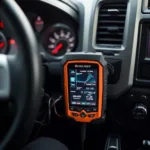The OBD2 code P17F6 can be a real headache for car owners. This article dives deep into the meaning of the P17F6 code, its common causes, symptoms, diagnostic procedures, and potential solutions. We’ll equip you with the knowledge you need to tackle this issue head-on, whether you’re a seasoned mechanic or a DIY enthusiast.
The P17F6 diagnostic trouble code (DTC) typically points to a problem within the transmission control system, often related to the hydraulic pressure control solenoid or the related circuitry. Understanding this code is crucial for accurate diagnosis and repair, preventing further damage to your vehicle’s transmission.
What Does OBD2 Code P17F6 Mean?
The OBD2 code P17F6 is a manufacturer-specific code. This means its specific definition varies depending on the vehicle’s make and model. However, it generally indicates a fault within the transmission control system, often related to a pressure control solenoid. The “F6” portion often refers to a specific solenoid or circuit within the transmission control module (TCM).
For example, in some vehicles, P17F6 might refer to an issue with the “Transmission Fluid Pressure Control Solenoid F.” In others, it could signify a problem with the wiring harness connecting the TCM to this solenoid. Consulting your vehicle’s specific repair manual is essential for precise interpretation.
Common Causes of P17F6
Several factors can trigger the P17F6 code. Here are some of the most frequent culprits:
- Faulty Transmission Control Solenoid: The solenoid itself can malfunction due to internal wear or electrical issues.
- Wiring Harness Problems: Damaged, corroded, or loose wiring within the transmission harness can disrupt communication between the TCM and the solenoid.
- Low Transmission Fluid Level: Insufficient fluid can cause pressure fluctuations, leading to the P17F6 code.
- Contaminated Transmission Fluid: Dirty or degraded fluid can impair the solenoid’s operation and trigger the code.
- TCM Malfunction: While less common, a faulty TCM can also cause the P17F6 code.
Symptoms of OBD2 Code P17F6
The symptoms associated with P17F6 can vary, but some common indicators include:
- Check Engine Light: The illumination of the check engine light is the most obvious sign.
- Harsh Shifting: The transmission may shift roughly or erratically.
- Slipping Transmission: The gears may slip, causing a loss of power.
- Limp Mode: The vehicle may enter “limp mode” to prevent further damage, limiting speed and performance.
- Trouble Codes Related to Transmission Performance: Other related codes may be present alongside P17F6.
Diagnosing OBD2 Code P17F6
Proper diagnosis is crucial to address the P17F6 code effectively. Here’s a general diagnostic procedure:
- Retrieve the Code: Use an OBD2 scanner to retrieve the specific P17F6 code and any other stored codes.
- Consult the Repair Manual: Refer to your vehicle’s specific repair manual to understand the precise definition of P17F6 for your make and model.
- Inspect the Wiring Harness: Carefully examine the transmission wiring harness for any visible damage, corrosion, or loose connections.
- Check Transmission Fluid: Verify the fluid level and condition. Low or contaminated fluid should be addressed.
- Test the Solenoid: Using a multimeter, test the resistance of the suspected solenoid according to the manufacturer’s specifications.
How to Fix OBD2 Code P17F6
The repair for P17F6 depends on the underlying cause. Here are some potential solutions:
- Replace the Faulty Solenoid: If the solenoid is determined to be defective, replacement is usually the necessary course of action.
- Repair the Wiring Harness: Damaged or corroded wiring should be repaired or replaced as needed.
- Change the Transmission Fluid and Filter: This is crucial if the fluid is low or contaminated.
- Replace the TCM: If the TCM is diagnosed as faulty, it will need to be replaced and reprogrammed.
“Accurate diagnosis is paramount when dealing with transmission codes like P17F6,” says automotive expert Michael Stevens. “Throwing parts at the problem without proper testing can be costly and ineffective.”
Conclusion
The OBD2 code P17F6 indicates a potential problem within your vehicle’s transmission control system. Understanding the code’s meaning, causes, symptoms, and diagnostic procedures is crucial for effective repair. While the specifics of the P17F6 code can vary between manufacturers, a systematic approach to diagnosis and repair, often involving checking the transmission solenoid, wiring harness, and fluid, will help you get your vehicle back on the road smoothly. Remember to consult your vehicle’s specific repair manual for accurate information and guidance relevant to your make and model.
Need help? Contact us via WhatsApp: +1(641)206-8880, Email: [email protected] or visit us at 789 Elm Street, San Francisco, CA 94102, USA. We have a 24/7 customer support team ready to assist you.

